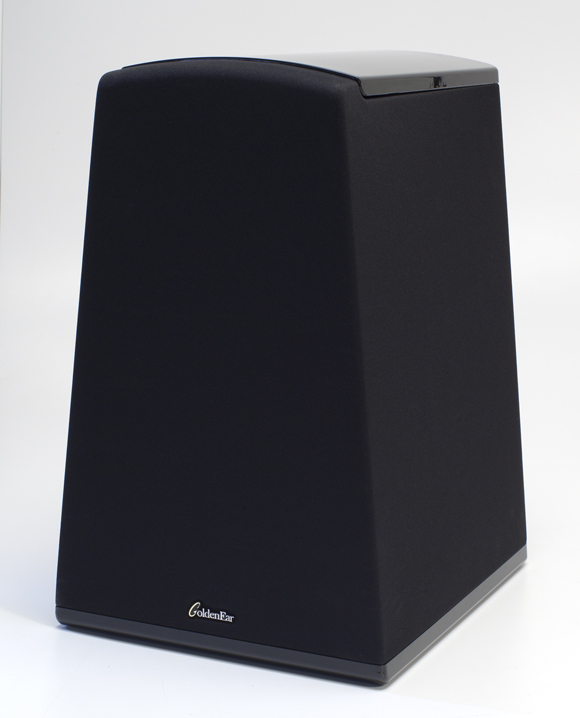 In the years since Bowers & Wilkins introduced the Zeppelin (now the Zeppelin Air), there have been many imitators, but no one has really come close to the combination of form and function that this innovative British company started. Until now.
In the years since Bowers & Wilkins introduced the Zeppelin (now the Zeppelin Air), there have been many imitators, but no one has really come close to the combination of form and function that this innovative British company started. Until now.
I got my first glimpse of the Crescendo at this year’s Consumer Electronics Show in the MartinLogan room – I thought it was a static display and I was listening to a pair of class-leading ElectroMotion speakers. When informed that I was listening to the Crescendo, it was a revelation. Hard to believe a desktop player could not only sound this good, but throw such an expansive stereo image. Justin Bright, MartinLogan’s PR guy, smiled and said, “You can hook it up to one of our subs for an even bigger sound,” which had me thinking about other possibilities.
Not everyone is brainwashed by Bose. Many want decent sound, don’t want to become audiophiles, yet sheepishly know that a Wave Radio is wrong. They always have that guilty look in their eyes when they ask, “So what should I buy?” Without question the Crescendo is the way to roll. For $895 you can’t beat it.
Major tech under the hood
The Crescendo utilizes a lot of existing MartinLogan technology to work its magic. The same folded motion tweeter design from the ElectroMotion speakers is at work underneath the grille, along with a 5×7-inch midwoofer speaker, crossed over at 3,600 Hz, so the effect is stereo up beyond that. It works remarkably well, giving as much of a stereo impression of any of the other tabletop portables I’ve experienced.
Combining a 50-watt amplifier for the woofer, a 2×25-watt amplifier for the tweeter and a full-blown DSP preamplifier, the Crescendo produces room-filling sound with ease. Blasting “Firehouse” from KISS 40 proves that the Crescendo is not just a pretty desktop with no guts. A long playlist of Nine Inch Nails (played at equally high volume) without damages to the Crescendo underlines its robustness.
The Crescendo is equally adept at moderate volume levels, and those enjoying more subdued fare will be just as happy as the headbangers in the audience. The subtle, waif-like vocal shadings of Sharon Van Etten on her Tramp LP are reproduced with the delicacy required. Equally delightful were the textured vocals in Jonsi’s GO.

Setup as easy as one, two, three – well six, actually.
There are six different ways to connect to the Crescendo: Via WiFi, Bluetooth, USB, line level, Toslink and a standard wired Ethernet cable, so no matter what you have, you’ll be able to plug in. I made it a point to try them all and had equally good luck. The enclosed quick start guide is very concise and this device works as described, so no matter what level of geekiness you posess, you should be up and running in a few minutes. The folks at MartinLogan have produced one of the best instruction manuals I’ve come across in years, so take ten minutes and read it.
As cool as this all is, the subwoofer output really adds to the Crescendo’s oomph. Not only can you use a wired subwoofer (with a switchable crossover at 80 Hz), Paradigm’s PT-1 wireless subwoofer controller and Monitor Sub 10 make for a killer combination. Adding an $849 subwoofer to the Crescendo might seem like overkill, but seeing I just happen to have these two items as reference components in my home theater system, it seemed like a smashing idea. Those on a more reasonable budget might want to consider the Paradigm Cinema Sub at $349, though you do give up wireless capability. It only took about 30 seconds of LL Cool J’s “I’m Bad” to convince me that adding the sub was a ton of fun.
For those going sans subwoofer, where you place the Crescendo will weigh heavily on its bass output. Even though you can boost the bass with the “bass mode” switch on the aluminum remote, this won’t be quite enough should you place the Crescendo in the middle of a room or on a freestanding table. Take advantage of room and surface gain – install the Crescendo against a wall or even in a room corner if possible. Just as you would with your favorite pair of conventional loudspeakers, experiment with position until the perfect balance between midrange clarity and bass weight is achieved.

A lovely package
The gorgeous, half-moon shape, available in black or walnut complements any décor and it fits marvelously in my little mid-century modern abode. So much so, that I might just be keeping the review sample. As cool as the Crescendo is, I think the folks at the MartinLogan custom shop, the same skilled artisans that produce MartinLogan ESL speakers in custom finishes, should offer a hardwood upgrade for the Crescendo. No doubt this baby is going to make its way into some stylish abodes – why not go all the way and really make it a work of art? I’d happily pay extra for this option.
Though the MartinLogan Crescendo has a winning combination of sound quality, build quality and ease of use, it’s a truly fun experience. Thanks to its wide range of connectivity, anyone can plug in, whether literally or wirelessly and be enjoying their music in seconds. And enjoy it you will.
MartinLogan Crescendo
MSRP: $899.95









